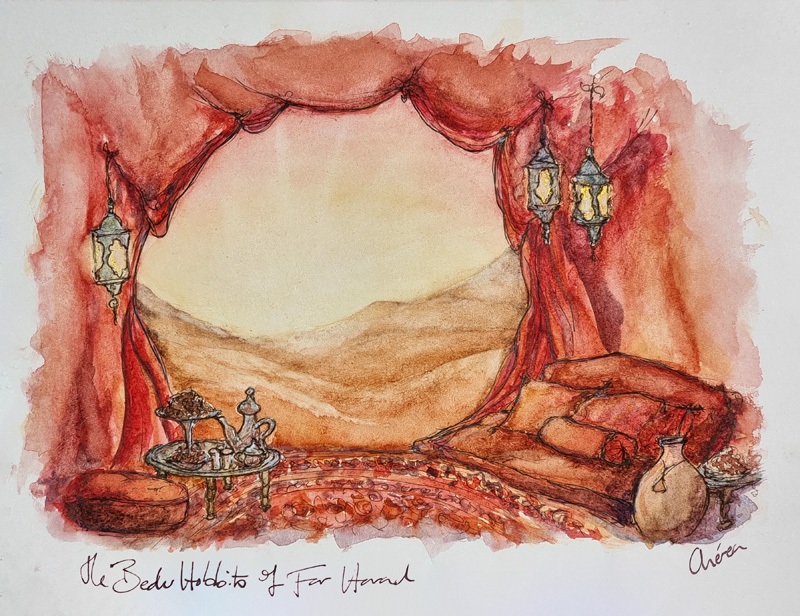Since it's highly unlikely that Eru plonked Hobbits down alongside the Anduin in Wilderland from the get-go where they hung about unnoticed until the early Third Age, their eventual migration to Eriador probably started in the east.
Eru knows where Hobbits originally came from, but even if they were among Men who awoke in Hildorien, I imagine the Hobbit ancestors avoided Morgoth's shenanigans simply because that kind of thing is just not in their very down-to-earth nature, and they were quite possibly the first to head (quietly sidle away) west, just to avoid getting stomped on by the larger folk.
By the Second Age they were living a pleasant nomadic lifestyle in the area that later became Harad. But as Númenórean coastal colonies expanded and Haradrim settlements increased, Hobbits would have been increasingly pressed into less hospitable areas. Terrain upheavals and climatic change caused by the rounding of the world would have been a catalyst for them to find a new land to call home. Some may have migrated further south, while others made their way north. With the area around the southern reaches of the Anduin being so populated, their route most likely first went east of Nurn (probably also fairly well populated by this stage thanks to its fertile soils, so not a safe spot for wee folk) then north-west past the gardens of the Entwives (later the Brown Lands), and eventually to the upper Anduin valley.
I think Hobbit-holes started out of necessity from their desire to remain out of sight, and mind, of big folk, and they developed a nifty technique of half burrowing their tents into dunes to form a kind of disguised fabric-lined hole.
They've always had good relations with Dwarves and traded with all the eastern clans along their migration, and so had metal and crystal crafted homeware even in their early days. I think they also gained some garden lore from the Entwives, which led to their vegetable growing championships.
Chapter End Notes
These are just a few ideas my sleepy brain has been able to write down and I'd love to hear your thoughts!



this illustration is so…
this illustration is so beautiful and so cozy and so warm! you've really captured the "Hobbit" aesthetic in a thing that isn't a hobbit hole and I love it!
♡
Thank you! I'm glad it feels cosy Hobbity. (I actually wouldn't mind staying there for a while!)
Given my love of teaching…
Given my love of teaching about Africa and any approach the legendarium that incorporates (in a celebratory way) cultures and influences outside of Western Europe, I absolutely love this. Headcanon 100% accepted! I agree with Azh that the warm colors make the work feel very comfortable and warm, and I love how you can almost see forward in time to Bag End: the tea kettle, the round door, the soft furniture, the warm light of the lamps.
♡
Thanks Dawn, I'm so pleased you like it. And I'm glad it carries a feel of Bagend too. (Some things don't really change that much!)
I have further headcanons about KhoiSan!Hobbits, those that migrated south instead of North, but that's a tale and painting/s for another day.
This is so gorgeous! It's so…
This is so gorgeous! It's so perfectly hobbitish while still being so different from the Shire, and the warm colors make it seem so cozy <33
♡
Thanks so much Starspray, I'm delighted you like it and find it so Hobbitish and cosy. May I pour you some tea and offer you a date-cake?.
An interesting and plausible…
An interesting and plausible theory. And the tent-hole is delightful!
♡
I'm so pleased my theory interests you and you like the Hobbit tenthole. I realise I got my timing muddled with the Entwives though: if the Hobbits only headed North after the changing of the world, the Entwives' gardens would have already been burned. Although there is the possibility, if any Entwives did survive (and I like to think some at least did) that the Hobbits met some further east, along the way.
If the Hobbits migrated…
If the Hobbits migrated directly directly after the changing of the world, there is a time window before the destruction of the land of the Entwives, which apparently happened during the War of the Last Alliance. It sounds shorter than it is, because of those long-lived Numenoreans, but it would be long enough for what you envisage, I think. (Not that I thought too hard about it earlier, but now that I'm checking, it's more than a hundred years, time enough for Elendil and his sons to found realms.)
Ahh, yes! Thanks for…
Ahh, yes! Thanks for unmuddling me. For some reason I was suddenly (un)thinking the Last Alliance was before the Change. 🙈